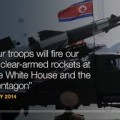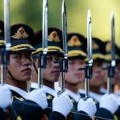by Frank V. Vernuccio, Jr., J.D.
Tensions in the Sea of Japan region are reaching the boiling point. As the diminished U.S. Navy no longer possesses the overwhelming power necessary to discourage any thoughts of aggression, and North Korean and Chinese military power continues to rise, the danger of a significant conflict grows rapidly. North Korea appears to be the most imminent threat.
Van Jackson, writing in Foreign Affairs, noted:
“Under Kim Jong Un, North Korea’s approach to developing its strategic forces is markedly different—more aggressive—than it was under his father or grandfather. The striking change puts the Korean Peninsula on a path to nuclear war unless the U.S.-South Korean alliance can adapt to the constraints of deterrence and defense against a second-tier nuclear-armed adversary. Whereas Kim Jong Il’s North Korea conducted 18 missile tests during his 18-year reign, the last four years under Kim Jong Un have already seen 35 missile launches and three nuclear tests. In word and deed, Kim Jong Un has laid bare his intentions to mate nuclear warheads to long-range missiles, pursue a hydrogen-based nuclear bomb, and develop a submarine-launched ballistic missile capability…Gone are the days in which it is possible to speculate that North Korea’s nuclear weapons were mere symbols or bargaining chips…”
38 North researchers, specializing in analyzing North Korean developments, warn:
“North Korea’s core weapons capabilities are reaching an apex. Even more concerning is the fact that North Korea’s relentless trial-and-error—…is principally generating its positive momentum. For policymakers in Washington and Seoul… North Korean weapons development highlights the urgency of reevaluating North Korea policy before it has perfected its nuclear and missile technologies…” In August, Pyongyang launched a missile, identified by U.S. sources as a KN-11, from a submarine. It travelled approximately 300 miles, indicating a significant new capability.
The ability to place nuclear weapons on submarine-launched missiles would virtually eliminate any ability of the world community to preemptively eliminate North Korea’s nuclear attack capability if such action became necessary in the event of either an attack by Pyongyang on South Korea, or a threatened nuclear assault on other nations. A further significant danger comes from North Korea’s willingness to export its military technology to unsavory customers.
According to the Arms Control Association, North Korea made extraordinary progress in building a world-class nuclear attack capability, in defiance of United Nations sanctions and prior agreements. On February 7, Pyongyang successfully launched “a long-range ballistic missile carrying what it has said is an earth observation satellite in defiance of United Nations sanctions barring it from using ballistic missile technology. Several months later, after several failures, North Korea achieved launches of its “Musudan” intermediate range missiles. A medium range missiles, the Nodong, was also successfully launched. Pyongyang has also fired up to three medium-range ballistic missiles simultaneously.
Perhaps most worrisome, as previously noted, it successfully launched its KN-11 missile from a submarine.
Beyond missiles, in 2016 North Korea conducted its fifth nuclear test, and began reprocessing nuclear material to separate additional plutonium for weapons use.
Despite the dire poverty that its population endures, North Korea has a greater number of its citizens under arms in its combined active duty and ready reserves (5,200,000) than the United States (2,500,000), has a roughly equal number of submarines, and possesses more towed artillery (4,300) than the U.S. (1,299) and multiple launch rocket systems (2,400 to 1,331) according to statistics provided by Global Firepower.
In October, U.S. Director of National Intelligence James Clapper stated that “the notion of getting the North Koreans to denuclearize is probably a lost cause.”
The ability of the once-preeminent power of the U.S. military to reduce tensions has been reduced sharply by the significant reduction in funding and general pacifism in dealing with major threats during the Obama Administration.
Frank V. Vernuccio, Jr., J.D. is the editor-in-chief of the New York Analysis of Policy & Government and the co-host of the popular WVOX weekly radio show, “And Nothing But The Truth.”

















Follow Us